 |
||
|
||
| ||
Having recently visited a local computer store, yours truly witnessed an amusing incident. One customer (a big guy) engaged practically all managers in the hall - he was boisterously ordering a computer of custom configuration, discussing every detail. As a result, he gathered a little queue behind him plus some idlers. The situation was under control, when they discussed a motherboard, a processor, a hard drive, and other components - the manager and two assistants, who were taking the order without much enthusiasm, were expertly going through the price list offering possible solutions. And then a clap of thunder out of a blue sky! The manager proceeded to the next component and asked: "What about a cooler? Which would you like? How about this one?" But the customer replied - "I want a liquid cooling system!" "What?" asked the manager. "I want a liquid cooler! The more powerful, the better. And it must be of high quality!" rumbled the customer. You should have seen the faces of this manager and his assistants! Their well-controlled faces instantly changed into a combination of surprise, confusion, misunderstanding, and other mixed feelings! They hectically looked through the price list, exchanged glances, one of the assistants ran across to his desk several times, the other "consultant" decided to made off. Finally, they actually found the right product (it took them more than fifteen minutes), the customer was quite pleased with himself and his choice as he was leaving the store. But the tired face of the manager clearly reflected what he thought of this enthusiast, who wanted a liquid cooler instead of a $50 cooler! :) Well, this half sad, half funny story affected not only its participants with opposite attitudes, but also made us reorganize our introduction to the review of today's cooling system. The first draft seemed too dry after this event. Indeed, the underlying basis of the current nasty situation with liquid cooling systems is very simple: liquid coolers were extremely popular several year ago, they were the first option considered by overclockers. But now, highly efficient coolers push them out of focus and price lists. Whichever way you look at it, the times of extremely hot processors have gone. Consequently, the same concerns "heavyweight" cooling systems. Of course, various configurations with multiple graphics cards may act as a backup air field (SLI or CrossFire), where liquid cooling systems are still justified. However, deploying liquid cooling systems in other complex cases is not imperative anymore. As a result, in most cases modern cooling systems are bought for purely esthetic reasons rather then to solve technical problems. It naturally limits their attractiveness to enthusiasts as well as vendors and retailers. Nevertheless, if we discard all extreme cases (weak systems with limited functionality or pretentious kits, where a single CPU block costs $200 and higher), we can point out a few very interesting liquid cooling kits for generic PCs offering a good selection of parameters at an adequate price. Thermaltake BigWater 760i belongs to such kits. We shall review it today. BundleWe'll start our examination with the bundle - it's very important both in technical terms and from the point of view of usability. Fortunately, our product under review has what to boast! 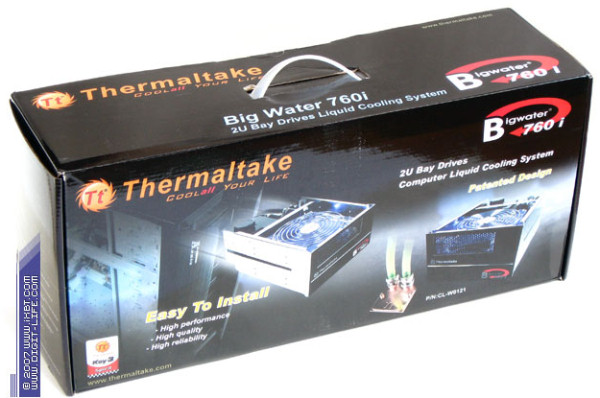 As a High-End product, the Big Water 760i comes in a large neat box with a comprehensive and illustrated description of what's inside. As we opened the box, we found two technical manuals, a box with mounting accessories, and a tube (about 4 meters long).  The box also contains the main block (it incorporates a pump, a heat sink with a fan, and an expansion tank), a processor block with a preinstalled retention bracket, a plastic tube for filling the system, and a 0.5 bottle of coolant (water solution of propylene glycol with anticorrosion additives). 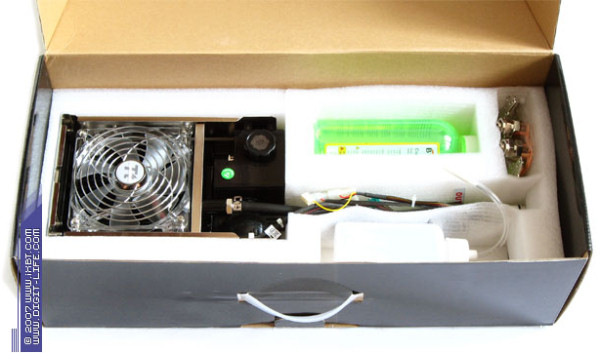 That is, we get the whole caboodle, including all necessary components for a processor-centric liquid cooling system, plus a couple of accessories to make it more convenient to maintain the system (a bottle of coolant and a filler tube). Not bad! I wonder how useful these components are in practice. What about their technical parameters? Let's find out! DesignSpeaking of design, the first thing you should pay attention to is technically neat integration of three main components (pump, heat sink, and expansion tank) into a single block.  Indeed, the Big Water 760i is not hidden in a tight closed housing (as it happens with similar products to be installed in 5.25" bays). It's mounted on an open frame, which contributes much to ventilation of the heat sink (especially when there is not enough air flow, which is typical of 5.25" bays) and gives more or less comfortable access to its internal components. We should also mention a vent hole on the front panel of the block, which also contributes to ventilation of the heat sink, and thus raises efficiency of the entire system. 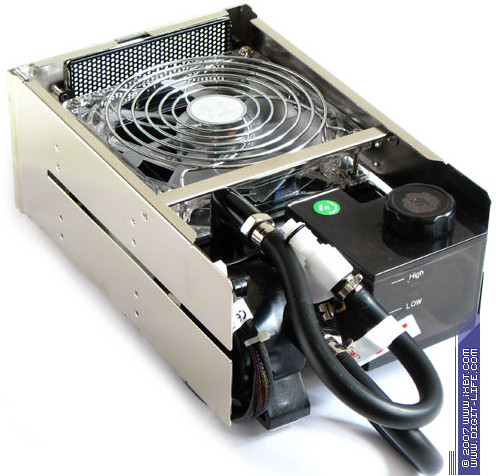 Another interesting feature of the Big Water 760i is its advanced heat sink - instead of simple fins (like in older Big Water products and the Big Water 735), it uses a much more efficient corrugated structure with a well known configuration for car enthusiasts (flat pipes plus corrugated tape). DTT (Dimple Tube Technology) acts as an additional technical ameliorant here: the inner surface of of the heat sink pipes is covered with rows of miniature "dimples", which turbulize the flow. They form places of active vorticity and mixing of the heat-carrying liquid, thus increasing the heat release from the carrier to pipes and fins. 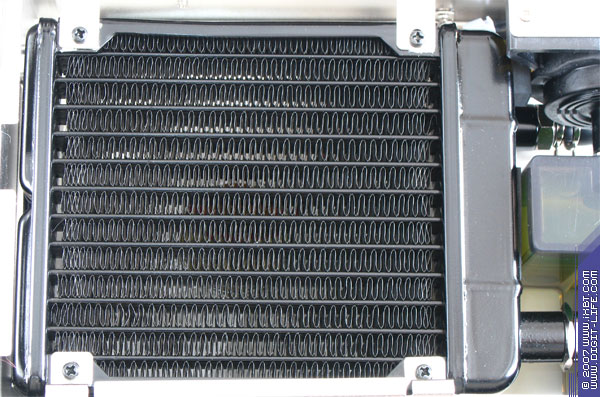 The Big Water 760i also has an interesting processor block - it's manufactured using high technologies to avoid any chances of leakage (brazing). It's quite compact and features a complex design with a section of narrow microchannels. It's an original solution, well though-out! We know that heat is exchanged mostly in a thin near-surface layer, there is almost no heat exchange in the core of the flow. Hence, large water blocks, often used by some manufacturers, are irrational. On the contrary, microchannels can significantly improve thermal efficiency of a water block - effective heat exchange surface area is expanded, flow speed is increased, so the heat exchange ratio also grows. 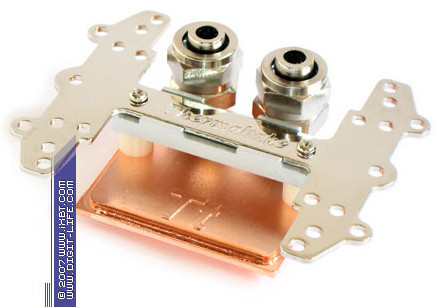
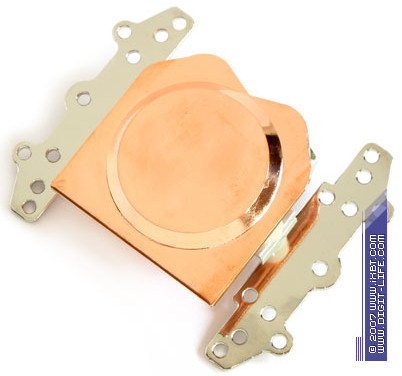 The Big Water 760i also has a good pump. Weak pumps used in older products are a thing of the past now. Nominal output of this pump is 500 l/h (running a few steps forward, we should note that the real performance with the heat sink and the water block is not far from this point - it exceeds 380 l/h). Technical quality of the pump is also very good - the new pump can compete with similar pumps popular among enthusiasts. OK, we've covered design peculiarities of this kit. Our impressions are very good so far! And now let's address its usability. UsabilityWhat does a user need from a liquid cooling system? We cannot speak for all, of course, but here is a general opinion: installation convenience in the first place, easy maintenance, and reliability of all components in this kit. These are three major requirements, other issues are of minor importance. 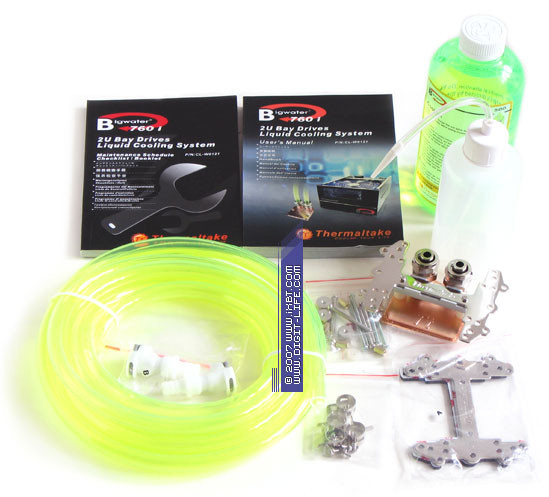 What concerns the first point, the Big Water 760i is doing fine. Retention module of the CPU block is compatible with various platforms (it can be installed on Intel LGA775 and on AMD Socket 754/939/AM2) and offers a rational installation procedure. In fact, it's an improved modification of the retention module used in the Big Typhoon - you can hardly expect a cardinally better solution, considering complex technical conditions of the water block. 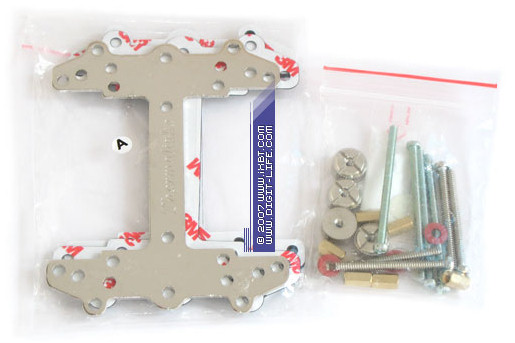 Connector valves (made by Colder, APC series) also significantly facilitate the process of connecting the main block with the water block, and make it much faster: you just cut necessary fragments of the tube, fix them on fittings of the water block and female-connectors of the valves, and then latch the valves - that's all! Then you open the expansion tank, pour the coolant in, "blow the system through" with a trial run, and the system is ready! You just have to mount the main block of the Big Water 760i into a 5.25" bay (it's a trivial procedure). By the way, you do not have to install the main block into a PC case, if you don't want - there are no problems with that. 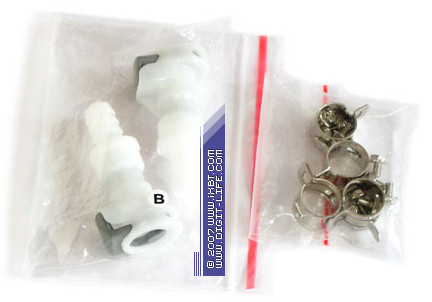 What concerns the second requirement, this cooling kit also performs well - owing to special Colder valves, you can easily detach the water block from the main block and plug it back, when you reinstall the cooling kit into a new computer. It's not difficult to replace coolant either. If you want to upgrade your system, for example, to add water blocks for graphics cards, an additional external pump or a heat sink, there won't be any problems with that either! The system uses tubes and fittings of the most popular format (3/8" or 9.5 mm), so optional components will fit like native ones. 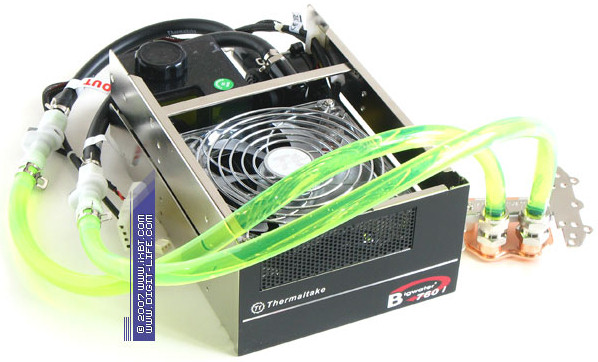 The Big Water 760i also meets the third requirement - all components of the system are of high quality. They are made to last, be it the monolithic CPU block, the pump with a ceramic bearing, a heat sink of the industrial design, or the tube made of good materials with special valves. Leakage is out of the question! However, we have several minor technological gripes. First of all, the fan speed control looks foolish (it varies fan speed from 1600 rpm to 2400 rpm) - it's plugged to the fan with a short "leash" and can be used only in a limited number of cases (it cannot be installed on the front panel or outside a PC case). By the way, we've already seen such a limiting implementation of controls - for example, the V1 cooler. Thermaltake engineers should have taken care of this problem. 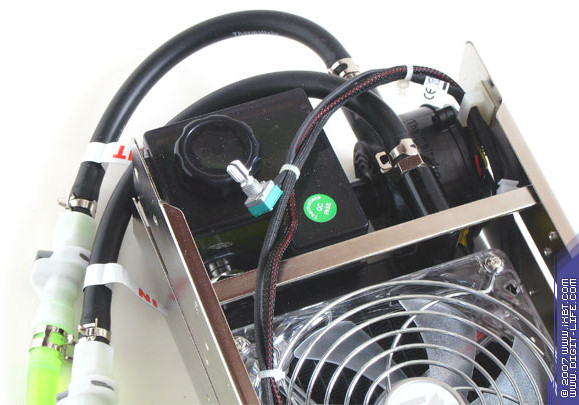 Besides, we are disappointed not to have a typical 3-pin connector to plug the fan into a motherboard, so you cannot control fan speed via BIOS, besides it makes it much more difficult to use third-party fan speed controllers. Although you can easily fix this problem with a soldering iron, it still hurts ergonomics of the Big Water 760i! Well, we've cleared up the usability issues, there is no need to elaborate. It's time to proceed to the main part of today's article - performance results of the Big Water 760i! Test resultsIn order to examine thermal efficiency of our liquid cooling kit, we put the same methods into service as in testing cooling systems for Socket 478 as well as Intel LGA775 and AMD Socket 754/939/AM2. The primary data used for the consequent calculation of thermal resistance are temperature readings of the thermal diode built into a processor. Only the thermal source (Pentium 4 550), the base platform (ASUS P5AD2-E Premium motherboard), and a set of applications are different. Besides, CPU voltage is raised to 1.525 V in order to generate more heat in the testbed. The resulting heat power is 150 W. Testbed configuration:
We use the S&M utility to create maximum thermal load on the processor and Speedfan to monitor temperatures. Thermal Monitor is disabled in all the tests. First of all, let's have a look at results of our cooling system in the stock configuration! Chart 1. Temperature readings (CPU core temperature), stock configuration
Chart 2. Noise characteristics, stock configuration
Impressive results! Pay attention to the catastrophic lag of the old Big Water (CL-W0005), where the limiting factors are a very weak pump and a simplified heat sink (they do not let the system reveal its full capacity, they actually bring to nought all advantages of liquid cooling). However, there is one unexpected issue here - a relatively high level of noise, when the fan works in the low-speed mode (1200 rpm). We've found out that the noise is generated by the pump, which wheel rotates at about 2600 rpm. So, the fast pump results in structural vibrations and noticeable electromechanical sounds, which has a negative effect on the overall technical image of the Big Water 760i. And now let's try to power the pump with 5 V and see how it works in this mode (the resulting speed is 1200 rpm)! Chart 3. Temperature readings (CPU core temperature), 5 V pump (1200 rpm)
Chart 4. Noise characteristics, 5 V pump (1200 rpm)
Not bad at all! Thermal efficiency is lower, of course (the real coolant rate goes down to 150 l/h), but changes are not relevant - advanced air coolers are still outperformed. But the situation with noise (with the fan rotating at medium speed) becomes truly ergonomic. By the way, a thorough examination shows that self-noise of the pump in this mode is 25 dBA, that is it goes down by 12 dBA relative to the full-speed mode, making this system practically noiseless in passive mode! And now let's see how the Big Water 760i responds to a Scythe Minebea fan (it's a model of high quality and performance for 120x120x25 mm products these days) instead of the stock Silentmatic SFA1225HU. Chart 5. Temperature readings (CPU core temperature), Scythe Minebea fan
Chart 6. Noise characteristics, Scythe Minebea fan
As we can see, thermal results remain practically the same. But noise characteristics again become more ergonomic - Scythe Minebea works better with this heat sink owing to its advanced aerodynamics. If you want a noiseless computer, it will be a justified ameliorant for the Big Water 760i. Finally, at the end of this chapter, we publish combined charts of thermal resistance, noise characteristics (you can read about the test procedure in the article Noise characteristics of coolers and the noise measurement method), and the efficiency/noise ratio of our cooling kit. Chart 7. Thermal resistance
Thermal resistance θja is defined as the relation Chart 8. Noise characteristics
Background noise level: 18 dBA Chart 9. Efficiency/noise ratio
The efficiency/noise ratio (ENR) is calculated as: ConclusionsThermaltake Big Water 760i proves that a liquid cooling system is still a rational choice: if the heat sink with a fan had offered a tad higher performance, and if the pump had been quieter, we would have got an absolute must have! But even the existing product is very attractive. Especially if the pump operates at medium speed, demonstrating optimal thermal results and an unprecedentedly high efficiency/noise ratio. And we shouldn't forget about upgradeability of this kit, of course. The Big Water 760i allows to plug various addons (water blocks, heat sinks, controllers, etc), which opens a lot of opportunities to upgrade your system and reinforce its thermal capacity. Thermaltake Big Water 760i gets our Original Design award. Let's hope that Thermaltake will continue to develop liquid cooling systems and please us with new interesting products. What concerns applicability of the Big Water 760i for complex PC cooling (including a graphics system), we'll get back to this issue, probably very soon. Thermaltake Big Water 760i kindly provided by Thermaltake Write a comment below. No registration needed!
|
Platform · Video · Multimedia · Mobile · Other || About us & Privacy policy · Twitter · Facebook Copyright © Byrds Research & Publishing, Ltd., 1997–2011. All rights reserved. |